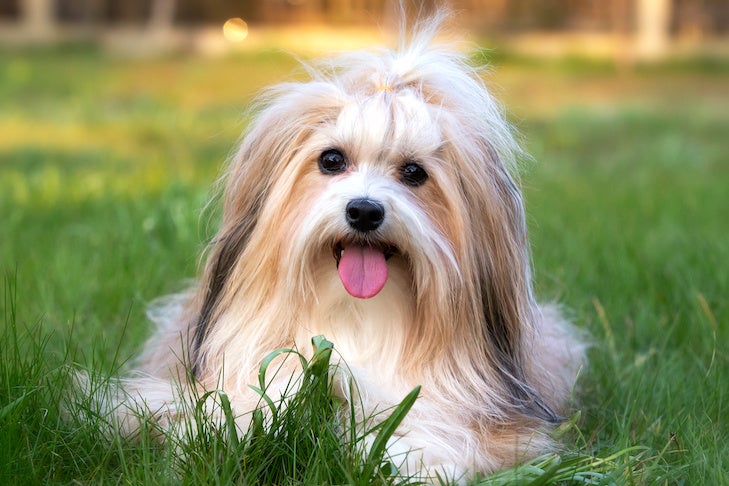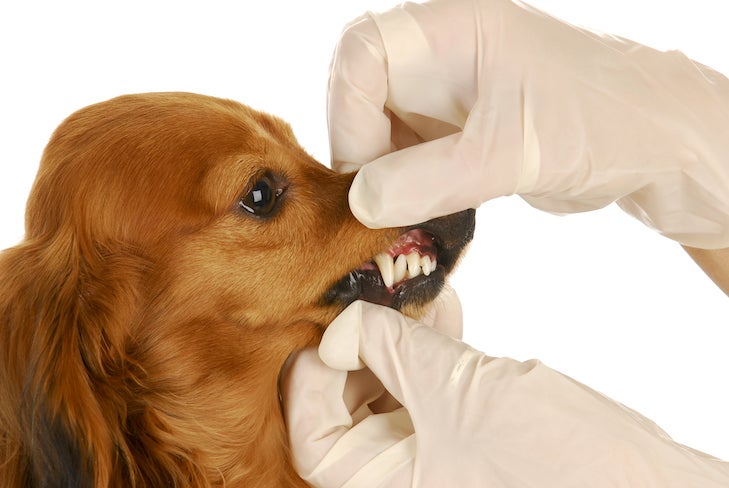When dentists advertise dental services for people, it’s all about creating pretty smiles. But for dogs, the veterinary reminders prompt a different story, as canine dental problems go deeper than a toothy grin. Small and large dogs experience different types of dental issues—all beginning with the size of their mouths. Adult dogs have 42 teeth—20 on the top, 22 on the bottom. Puppies have 28—14 on the upper jaw, 14 on the lower jaw. While the mouths of large dogs can accommodate all these teeth, the jaws on small dogs do not.
Small Dogs, Petite Mugs
“The biggest dental problem for little dogs is periodontal disease,” says Jan Bellows, DVM, Past President of the American Veterinary Dental College and a Board Certified Veterinary Dentist in Weston, Florida.
Fitting all 42 teeth in a small mouth is a challenge. By the time they’re 12 years old, Toy breeds often have only half of their teeth “Their mouths are crowded, and teeth grow close together and at odd angles,” says Dr. Bellows. As a result, plaque builds up, turns into tartar, and food bits become lodged between the teeth.
For example, when people eat popcorn and a kernel gets stuck between their teeth, they can brush or floss to remove it, but dogs can’t.“When the tartar accumulates, infection sets in under the gum line,” says Tony Woodward, DVM, a Board Certified Veterinary Dentist in Bozeman, Montana.

“With some brachycephalic dogs, teeth can even grow in sideways. A hard piece of food can stay there for years,” Dr. Woodward says. “Many little dogs don’t chew their food as much—especially if they’re fed a lot of soft food, so more plaque and calculus build up and leads to inflammation of the gums.”
Routine dental care guards against periodontal disease, tooth loss, and infection, which can make eating painful and difficult.“Small dogs can have abscessed teeth and hide it so well that their owners never suspect a problem,” says Dr. Woodward. “This ability to not show weakness goes back to their canine ancestors who had to protect themselves from predators.”
Bad breath isn’t only about smelling a foul odor. It’s usually a sign of periodontal disease and often accompanies red, inflamed gums that bleed easily. Small dogs with putrid breath need a professional dental cleaning at the veterinarian’s office under anesthesia twice a year.
“Non-essential dental cleaning without anesthesia will only remove surface tartar,” says Dr. Bellows. “Without anesthesia, it’s impossible to reach below the gum line.”Although regular tooth brushing is usually recommended to keep tartar from accumulating on teeth, Dr. Bellows recommends wiping the teeth once or twice a day after a meal. The friction can help remove plaque, especially on the lower jaw. If you see yellow or brown stained teeth, the dog has already fallen behind schedule for a professional dental cleaning.
Large Dogs, Big Choppers
Large dogs are far from immune to dental problems, but the reasons differ significantly from smaller canines. “The primary issues are fractured teeth and trauma,” says Dr. Woodward. Rough and tumble large breeds thrive on going after sticks, playing tug with another dog or their owner, and chewing on hard objects, such as antlers or bones.
Unfortunately, these activities lead to breaking the chewable back teeth. If active play wasn’t enough to cause dental damage, grabbing the roots of a tree, chewing rocks in the yard, or bumping heads with another dog after going for the same toy cause tooth trauma. The American Dental College reports research shows that almost a third (20 to 27 percent) of canine patients have fractured teeth. “Another dental issue for Labrador Retrievers and Golden Retrievers is oral cancer,” says Dr. Bellows. “With all large dogs, teeth can fail to erupt, or they can grow in the wrong spot.”

Caring for Cuspids
Both veterinary dentists recommend a regular professional dental cleaning for large dogs once a year under anesthesia. During this time, the veterinarian should take x-rays of the dog’s mouth for an accurate picture of the dental condition.
After this procedure, wipe the teeth once a day with a small washcloth. “Brushing teeth helps, but you can’t always reach every tooth,” says Dr. Woodward. “Give dogs chew toys that bend and avoid any hard bones that can break their back teeth.”Good dental care begins early. When the puppy receives its first or second set of vaccines, the veterinarian should examine the pup and look inside his mouth.
“If, for example, there’s an abnormal growth or a bottom tooth is hitting the roof of the mouth, the veterinarian can spot it immediately and take care of it,” says Dr. Bellows. “A healthy mouth is all about prevention.”

